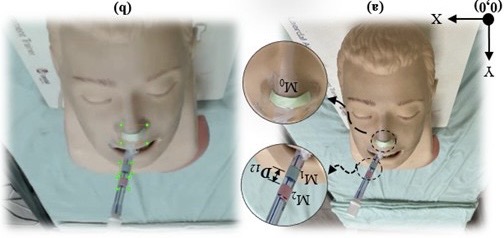Introduction
Endotracheal intubation is a common and vital clinical procedure commonly performed in modern medical practice, where a tube is inserted into a patient's trachea to facilitate mechanical ventilation. However, post-intubation, various factors can lead to Endotracheal Tube Displacement (ETD). Such displacement can compromise oxygen delivery and pose life-threatening risks to the patient. Recognizing this challenge, our team has developed a deep learning-based monitoring system for detecting ETD, named "EndoEye". Comprising image sensors and AI edge computing components, EndoEye can be directly mounted above the patient's bed for real-time tube position detection. Moreover, EndoEye can seamlessly integrate with the hospital's electronic information systems, logging each tube displacement event instantly. The key features of this system include:
1. Real-time Dynamic Motion Alerts: Utilizing deep learning image recognition technology, EndoEye can continuously monitor rapid body movements of the patient. If the system identifies any unusual movement or agitation indicating potential ETD, EndoEye will instantly issue a vocal alert, prompting medical staff to inspect.
2. Tube Displacement Notifications: EndoEye's advanced image recognition can precisely locate the markers on the endotracheal tube. If the system detects any marker movement exceeding 1 centimeter, indicating an ETD occurrence, an immediate alert is triggered, ensuring that the medical team can take swift corrective actions.
3. Nursing Information System Integration: Beyond its effective monitoring and alerting capabilities, EndoEye can be integrated with a hospital's Nursing Information System, enabling nursing staff to quickly understand the patient's endotracheal intubation status during handovers, thus enhancing nursing efficiency and quality.
Features / strengths
In today's clinical healthcare environment, an effective tool must offer precise monitoring, real-time alerts, and also be cost-effective. When addressing ETD events, there's a notable absence of a truly suitable monitoring device in the clinical sphere. Recognizing this need, our team introduces EndoEye, a product that promises accuracy, immediacy, and economic efficiency all in one. Here are the five core advantages of EndoEye:
1. Fine-scale Displacement & Facial Dynamics Recognition: EndoEye, harnessing the prowess of state-of-the-art deep learning image recognition paradigms, is adept not only at discerning nuanced displacements (inferior to 1 cm) of the tracheal tube but also exhibits proficiency in ascertaining patient agitation manifestations, thereby preemptively alerting for potential ETD episodes.
2. Expeditious Real-time Surveillance & Alerts: One of EndoEye's eminent features is its laudable response latency, clocking under 0.5 seconds. In scenarios where patient agitation or ETD is detected, an immediate auditory alert is disseminated. This instantaneous alert paradigm critically truncates the latency in medical intervention, fostering prompt and appropriate clinical actions.
3. Procedure Streamlining & Fiscal Prudence: A plethora of extant tracheal tube surveillance modalities are contingent upon ancillary hardware components. Such a dependence invariably augments clinical procedural intricacy and concomitant expenditure. Contrarily, EndoEye's architectural blueprint circumvents these impediments, proffering a more parsimonious and cost-effective alternative.
4. Integration with the Nursing Information System: EndoEye interfaces with the hospital's Nursing Information System. Should a patient display signs of agitation or undergo an ETD event, the system automatically logs the incident. This significantly reduces manual errors and operational hours, thereby enhancing nursing efficiency.
5. Ubiquitous Applicability: Regardless of the scale or nature of medical establishments, from expansive healthcare centers to diminutive clinics, EndoEye's design exhibits a universal adaptability. Its perspicuous and intuitive user interface implies that a modicum of training suffices for healthcare professionals to assimilate its operational protocols comprehensively.
Specification in detail
Size
Approximately 10cm x 8cm x 6cm
Accessories
User Manual, Installation Kit (CD-ROM), Power Supply Adapter


